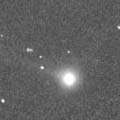
|
It had been observed while brightening rapidly until the perihelion passage on Apr. 19, although it located extremely low in the evening sky. It reached to 6.7 mag on Apr. 17 (Juan Jose Gonzalez). Although it had been unobservable for a while, it appeared in the morning sky in the Southern Hemisphere. Now it is 7.8 mag (May 9, Alexandre Amorim). It will be bright and observable for a while after this. In the Northern Hemisphere, it appears in the morning sky at 12 mag in June. But it locates only 20 degree high at most, and it will be fading rapidly.
Date(TT) R.A. (2000) Decl. Delta r Elong. m1 Best Time(A, h)
May 5 2 8.68 0 44.8 0.534 0.527 17 7.0 5:12 (270, -2)
May 12 1 35.14 -6 10.5 0.510 0.655 34 7.9 5:17 (267, 15)
|

|
New comet discovered in March in the Southern Hemisphere, but it is moving northwards very fast. It appeared in the morning sky also in the Northern Hemisphere in early April, and it is already observable in the excellent condition now. It passed near by the earth in mid April, and reached to 7.6 mag (Apr. 18, Juan Jose Gonzalez). But then it faded a bit, and now it is 8.8 mag (May 6, Mike Linnolt). After this, it keeps observable until it fades out in the Northern Hemisphere. It will be visible visually until July.
Date(TT) R.A. (2000) Decl. Delta r Elong. m1 Best Time(A, h)
May 5 17 46.79 45 50.0 0.527 1.259 105 8.5 3:00 (180, 10)
May 12 16 44.59 57 22.4 0.657 1.317 102 9.3 1:31 (180, -2)
|
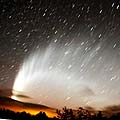
|
Excellent great comet, few times in a lifetime, for southern people. It reached to -5.5 mag on Jan. 14 and 15, brighter than Venus, and visible even in daytime. Then it appeared in the evening sky in the Southern Hemisphere and many people enjoyed a fantastic view of a beautiful great comet, a enormous curving tail with so many striae over 50 degrees. Now it is observable both in the evening and morning. It has already faded down to 9.6 mag (Apr. 19, Stuart Rae). In the Southern Hemisphere, It keeps observable almost all night until the comet has gone. It will never be observable again in the Northern Hemisphere.
Date(TT) R.A. (2000) Decl. Delta r Elong. m1 Best Time(A, h)
May 5 2 11.73 -81 39.4 2.046 2.400 97 10.3 5:12 (350, 34)
May 12 3 29.35 -83 32.8 2.100 2.505 101 10.6 18:35 ( 8, 34)
|

|
Although it was so faint as 13.8 mag in March (Mar. 17, Alan Hale), it brightened very rapidly in early April, and it reached to 8.7 mag on Apr. 10 (Werner hasubick). Then it faded a bit, and now it is 10.2 mag (May 5, Juan Jose Gonzalez). The comet is very large, extremely diffuse. It still locates high in the evening now. However, it will be fading, and getting lower rapidly after this. It will be unobservable in late May.
Date(TT) R.A. (2000) Decl. Delta r Elong. m1 Best Time(A, h)
May 5 7 55.93 19 36.8 1.188 1.317 73 10.6 18:40 (153, 31)
May 12 7 42.99 20 57.1 1.391 1.298 63 10.9 18:35 (146, 26)
|

|
The condition was too bad to observe on the earth before the perihelion passage, but it was visible in the SWAN images in mid March, and in the LASCO images in early April. After the perihelion passage on Apr. 4, it appeared in the morning sky and it was so bright as 5.5 mag (Apr. 10, Michael Jager and Gerald Rhemann). Then it is fading rapidly. But it is bright as 10.9 mag still now (Apr. 29, Seiichi Yoshida). Unexpectedly, it is well condensed and easy to see. The condition will get better rapidly after this. However, the comet will fade out rapidly. It will be fainter than 14 mag in mid May, too faint to see visually.
Date(TT) R.A. (2000) Decl. Delta r Elong. m1 Best Time(A, h)
May 5 22 22.62 21 21.5 0.701 0.922 62 12.1 5:12 (216, 24)
May 12 21 47.80 20 12.4 0.660 1.066 76 12.9 5:17 (201, 32)
|

|
Originally considered as a peculiar asteroid, but revealed to be a comet. It approached to Sun down to 0.6 A.U. in late April, then it will pass very near by Earth in May. Now it is bright as 14.1 mag (May 2, Ernesto Guido and Giovanni Sostero). In the Northern Hemisphere, it will appear at 12.5 mag in the evening sky on May 23, then it moves eastwards very fast. It keeps observable in the evening sky, but it will fade out rapidly. It will be 15 mag in early June, and will be fainter than 18 mag in late June. In the Southern Hemisphere, it is also observable in the morning low sky from late April to mid May. Because it is an extremely tiny comet, it may fade out much faster than expected.
Date(TT) R.A. (2000) Decl. Delta r Elong. m1 Best Time(A, h)
May 5 1 0.69 -10 18.0 0.773 0.609 37 13.9 5:12 (270, 18)
May 12 1 40.41 -7 56.3 0.498 0.663 34 13.2 5:17 (269, 16)
|

|
It became brighter than expected, and now it is visible visually at 13.5 mag (Apr. 28, Seiichi Yoshida). However, it is getting lower gradually in the evening sky, and it will be too low to observe in early June. It is not observable around the perihelion passage in July in conjunction with the sun. Then it moves to the southern sky, and it will be unobservable in the Northern Hemisphere.
Date(TT) R.A. (2000) Decl. Delta r Elong. m1 Best Time(A, h)
May 5 5 51.03 36 6.7 2.631 2.054 45 13.8 18:40 (139, 3)
May 12 6 9.37 34 44.6 2.641 2.014 42 13.7 18:35 (137, 3)
|

|
In this season, it has been bright as 12-13 mag and visible visually since it appeared in the morning sky in early July. It is visible visually as 12.5 mag still now (Apr. 12, Vitali Nevski). However, it is already getting lower in the evening sky, and it will be unobservable soon.
Date(TT) R.A. (2000) Decl. Delta r Elong. m1 Best Time(A, h)
May 5 4 35.25 28 56.2 6.776 5.907 28 13.9 18:40 (122, -5)
May 12 4 41.30 29 2.3 6.826 5.909 22 14.0 18:35 (120, -7)
|
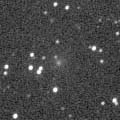
|
Getting higher in the morning sky. It is already bright as 14.8 mag by CCD (Apr. 27, Ken-ichi Kadota), and already visible visually at 13.3 mag (Apr. 28, Seiichi Yoshida). It will brighten rapidly after this, and reach to 9 mag in July. However, it moves southwards very fast in August. It is only observable until mid August in the Northern Hemisphere. On the other hand, it keeps low and hard to observe until mid July in the Southern Hemisphere.
Date(TT) R.A. (2000) Decl. Delta r Elong. m1 Best Time(A, h)
May 5 23 18.44 33 13.0 2.345 1.859 49 14.7 5:12 (220, 8)
May 12 23 19.79 34 50.7 2.165 1.775 54 14.4 5:17 (213, 10)
|

|
It kept 12 mag for over half a year since last June. It was still bright as 12.6 mag on Mar. 9 (Edwin van Dijk). But it has already started fading, and will be already too faint to see visually. However, the fading is slow. The comet will be fainter than 18 mag in 2008. In the Northern Hemisphere, it keeps observable until that time. In the Northern Hemisphere, it keeps observable all night for a while after this.
Date(TT) R.A. (2000) Decl. Delta r Elong. m1 Best Time(A, h)
May 5 2 40.17 70 4.7 3.261 2.791 54 14.5 5:12 (204,-36)
May 12 3 7.04 69 21.2 3.364 2.846 51 14.7 5:17 (205,-35)
|

|
It has been visible at 13.5 mag for a long time since 2005 autumn until 2006 spring. Now it is fainter than last year by 1 mag, however, it is still visible visually at 14.2 mag (Dec. 22, Seiichi Yoshida). Fine tail is visible on CCD images. It keeps observable in excellent condition until May.
Date(TT) R.A. (2000) Decl. Delta r Elong. m1 Best Time(A, h)
May 5 12 41.95 22 52.6 5.243 5.949 130 14.9 21:50 (180, 32)
May 12 12 39.98 22 22.6 5.338 5.974 124 14.9 21:20 (180, 33)
|

|
Now it is 15.2 mag (Feb. 24, Ken-ichi Kadota). Although it had been unobservable since last autumn, now it is appearing again in the morning sky. It will be observable at 14.5 mag from spring to summer both in 2007 and 2008. The condition is good, and it may be visible visually.
Date(TT) R.A. (2000) Decl. Delta r Elong. m1 Best Time(A, h)
May 5 18 42.58 -7 59.9 5.297 5.892 121 14.9 3:54 (180, 63)
May 12 18 37.07 -7 19.3 5.183 5.876 129 14.9 3:21 (180, 62)
|

|
It is observable in good condition in the Southern Hemisphere, although it is already not observable in the Northern Hemisphere. It has been 13-14 mag for a long time since last autumn. It is 12.5 mag visually, much brighter than this ephemeris (Apr. 17, Michael Mattiazzo). However, it will be fading gradually after this.
Date(TT) R.A. (2000) Decl. Delta r Elong. m1 Best Time(A, h)
May 5 16 14.60 -74 18.5 1.991 2.649 120 15.0 1:27 ( 0, 51)
May 12 16 2.14 -73 45.0 2.006 2.702 123 15.1 0:47 ( 0, 51)
|
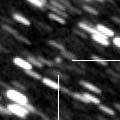
|
It brightened up to 17.5 mag in 2006 autumn, then it became unobservable. But now it is appearing in the morning sky again. Now it is 15.8 mag (May 3, Tony Farkas), brightening as expected. It will reach to 14.5 mag in 2007 summer. However, it moves in the southen sky. In the Northern Hemisphere, it rises up to 20 degree at best in May, then it becomes unobservable in July.
Date(TT) R.A. (2000) Decl. Delta r Elong. m1 Best Time(A, h)
May 5 20 56.40 -25 33.2 3.532 3.751 94 15.5 5:12 (235, 75)
May 12 20 56.05 -27 13.0 3.376 3.717 101 15.3 5:17 (213, 81)
|

|
Now it is 15.2 mag (Feb. 24, Ken-ichi Kadota). It will reach to 11 mag in 2008 spring. It keeps moving in the southern sky until that, so it keeps locating very low in the Northern Hemisphere. Now it is observable in good condition in the Southern Hemisphere, but already not observable in the Northern Hemisphere. In the Northern Hemisphere, it will be observable again in a short time in the very low sky at dawn in November at 13 mag. After 2008 March, it will be visible visually at 11 mag in the morning low sky.
Date(TT) R.A. (2000) Decl. Delta r Elong. m1 Best Time(A, h)
May 5 5 30.26 -27 53.9 5.399 4.959 59 15.4 18:40 ( 80, 39)
May 12 5 37.07 -27 24.4 5.382 4.908 57 15.4 18:35 ( 79, 36)
|

|
It reached up to 4 mag in 2006 autumn. But it had faded down to 10.5 mag on Jan. 11 (Carlos Labordena). It had been unobservable for a long time since that, but now it is appearing at dawn again. Now it is 15.8 mag (Apr. 28, Ken-ichi Kadota), fading as predicted. After this, it keeps observable until it becomes fainter than 18 mag in autumn.
Date(TT) R.A. (2000) Decl. Delta r Elong. m1 Best Time(A, h)
May 5 23 0.78 -10 53.5 3.733 3.379 61 15.4 5:12 (250, 43)
May 12 23 2.89 -11 31.3 3.700 3.459 68 15.5 5:17 (244, 49)
|
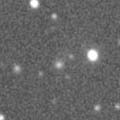
|
Now it brightened up to 15.8 mag (Mar. 11, Ken-ichi Kadota). It keeps 15.5-16 mag for one year and a half after this until 2008 summer. However, because the comet moves southwards, it is only observable until 2007 June in the Northern Hemisphere.
Date(TT) R.A. (2000) Decl. Delta r Elong. m1 Best Time(A, h)
May 5 10 12.13 -0 30.7 2.911 3.401 110 15.8 19:20 (180, 56)
May 12 10 12.64 -1 3.4 2.963 3.359 104 15.8 18:53 (180, 56)
|
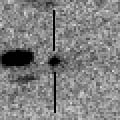
|
It keeps 15-15.5 mag for a long time until October, and keeps observable in good condition.
Date(TT) R.A. (2000) Decl. Delta r Elong. m1 Best Time(A, h)
May 5 22 28.61 -7 13.8 2.862 2.652 67 16.0 5:12 (239, 46)
May 12 22 39.95 -6 28.8 2.776 2.639 71 15.9 5:17 (233, 49)
|

|
Not observed in this return yet. It will appear in the morning sky at 16 mag in mid April in the Southern Hemisphere, and in early May in the Northern Hemisphere. Then it keeps 16 mag for a long time until November.
Date(TT) R.A. (2000) Decl. Delta r Elong. m1 Best Time(A, h)
May 5 0 17.78 8 13.0 2.766 2.053 37 16.2 5:12 (248, 16)
May 12 0 31.16 10 26.0 2.723 2.054 39 16.2 5:17 (243, 18)
|

|
Finally it has passed the perihelion, keeping almost asteroidal. It did not brighten at all since early September, and finally it reached to 14 mag at best. It kept locating in good condition, and being observed at 14 mag for a long time in the Northern Hemisphere. However, it has already started fading rapidly since March. It will be getting lower after this, and will be too low in the evening sky at 17 mag in June.
Date(TT) R.A. (2000) Decl. Delta r Elong. m1 Best Time(A, h)
May 5 7 53.40 10 19.1 2.065 2.043 74 16.3 18:40 (148, 39)
May 12 8 6.34 8 49.2 2.202 2.110 71 16.4 18:35 (145, 40)
|
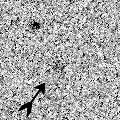
|
It will reach to 10.5 mag and will be observable in good condition in 2008 autumn. Now it is 16.7 mag (Apr. 18, Tony Farkas), brightening as expected. It keeps observable in good condition for a long time while the comet is getting brighter slowly.
Date(TT) R.A. (2000) Decl. Delta r Elong. m1 Best Time(A, h)
May 5 22 0.39 -12 49.2 5.669 5.518 76 16.5 5:12 (238, 55)
May 12 22 2.99 -12 19.8 5.506 5.464 82 16.4 5:17 (227, 60)
|

|
Now it is 16.8 mag (Mar. 25, Ken-ichi Kadota). It is outside of Jupiter's orbit. So it keeps 17 mag for a long time until 2007 summer. It keeps locating high and observable in good condition for a long time after this because it moves in the northern sky.
Date(TT) R.A. (2000) Decl. Delta r Elong. m1 Best Time(A, h)
May 5 14 4.64 39 52.0 6.792 7.393 123 16.7 23:12 (180, 15)
May 12 13 59.98 39 22.2 6.852 7.411 120 16.7 22:40 (180, 16)
|

|
It will reach to 12 mag in 2008 summer. In the Northern Hemisphere, it keeps observable almost all time until that while the comet is brightening gradually. However, it goes to the southern sky and will never be observable again in the Northern Hemisphere after that.
Date(TT) R.A. (2000) Decl. Delta r Elong. m1 Best Time(A, h)
May 5 17 54.76 35 29.3 5.510 5.959 111 17.0 3:06 (180, 20)
May 12 17 50.18 35 47.1 5.413 5.907 114 16.9 2:34 (180, 19)
|

|
It was observed as 17 mag in 2006 summer. Now it is getting higher again in the morning sky. It will be observable at 16.5-17 mag in good condition in 2007 summer.
Date(TT) R.A. (2000) Decl. Delta r Elong. m1 Best Time(A, h)
May 5 21 5.26 7 9.3 5.902 5.874 83 17.0 5:12 (203, 45)
May 12 21 3.53 8 11.8 5.785 5.870 89 17.0 5:17 (191, 46)
|
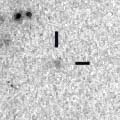
|
Now it is 17.7 mag (Mar. 12, Ken-ichi Kadota). It keeps 17 mag until July when it starts getting lower in the evening sky. It will be observable again at 18 mag in 2008.
Date(TT) R.A. (2000) Decl. Delta r Elong. m1 Best Time(A, h)
May 5 13 50.38 -11 48.5 3.752 4.736 165 17.1 22:58 (180, 67)
May 12 13 47.21 -11 35.2 3.786 4.739 158 17.1 22:27 (180, 67)
|

|
Now it is 17.3 mag (Mar. 11, Ken-ichi Kadota). It keeps 17 mag until May, then it will be lower in the evening sky while fading in June.
Date(TT) R.A. (2000) Decl. Delta r Elong. m1 Best Time(A, h)
May 5 10 45.42 8 0.5 1.587 2.220 115 17.2 19:54 (180, 47)
May 12 10 50.04 7 41.7 1.649 2.210 110 17.3 19:31 (180, 47)
|

|
It will reach to 16.5-17 mag in June and July. It locates rather low in the Northern Hemisphere.
Date(TT) R.A. (2000) Decl. Delta r Elong. m1 Best Time(A, h)
May 5 20 53.95 -2 6.0 3.020 3.163 88 17.4 5:12 (203, 55)
May 12 20 53.51 -3 25.5 2.897 3.163 95 17.3 5:17 (189, 58)
|
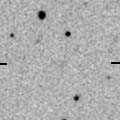
|
Now it is 18 mag. It will approach down to 0.4 A.U. to the sun in late October, and it is expected to reach to 6 mag. However, the condition in the Northern Hemisphere is very hard. It will be getting lower in the evening sky after this. The altitude becomes lower than 20 degree in early July, and lower than 10 degree in late July. The comet is still faint as 15.5 mag at that time. After conjunction with the sun, the comet will be brighter than 11 mag in late September, and will be 8 mag in mid October. But it locates extremely low, slightly over the horizon in the morning sky. It goes to the southern sky in late October, then it will never be observable again. In the Southern Hemisphere, it becomes unobservable in July. But it will appear in the evening sky at 7.5 mag in mid November. Then it keeps observable while fading gradually, although it will not locate very high.
Date(TT) R.A. (2000) Decl. Delta r Elong. m1 Best Time(A, h)
May 5 10 20.54 27 43.6 2.741 3.114 102 17.6 19:28 (180, 27)
May 12 10 14.65 28 12.6 2.775 3.024 94 17.5 18:55 (180, 27)
|

|
It will be observable at 14 mag in good condition in 2008 spring. Now it is still faint as 18 mag, and getting lower in the evening sky after this. But it will appear in the morning sky again at 16.5 mag in October. Then it keeps observable in good condition until 2008 summer.
Date(TT) R.A. (2000) Decl. Delta r Elong. m1 Best Time(A, h)
May 5 9 16.20 39 57.6 5.305 5.318 85 17.6 18:40 (177, 15)
May 12 9 18.30 39 10.4 5.356 5.269 79 17.6 18:35 (173, 15)
|

|
Fading is slower than expected. It is 17 mag still in April. It will be observable at 17-18 mag for some more time.
Date(TT) R.A. (2000) Decl. Delta r Elong. m1 Best Time(A, h)
May 5 15 46.43 59 50.7 5.009 5.330 103 17.6 0:58 (180, -5)
May 12 15 33.76 60 23.3 5.097 5.391 101 17.7 0:18 (180, -5)
|

|
It reached to 16 mag in early 2006. Now it is 17.7 mag (Feb. 3, Ken-ichi Kadota). It will be fading very slowly from 17 mag to 18 mag until summer. In the Northern Hemisphere, it keeps locating high.
Date(TT) R.A. (2000) Decl. Delta r Elong. m1 Best Time(A, h)
May 5 13 51.16 33 27.1 5.340 6.024 128 17.6 22:58 (180, 22)
May 12 13 47.69 32 55.2 5.414 6.053 125 17.7 22:27 (180, 22)
|
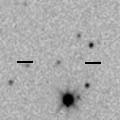
|
Now it is 18.2 mag (Mar. 14, Ken-ichi Kadota). It keeps observable in the evening sky at 17.5 mag until autumn when it becomes fainter than 18 mag, although the altitude will be getting lower after May.
Date(TT) R.A. (2000) Decl. Delta r Elong. m1 Best Time(A, h)
May 5 10 24.63 18 5.6 1.216 1.794 107 17.7 19:33 (180, 37)
May 12 10 31.38 17 50.5 1.248 1.761 101 17.7 19:13 (180, 37)
|
|
![]()
 C/2006 M4 ( SWAN )
C/2006 M4 ( SWAN ) C/2006 V1 ( Catalina )
C/2006 V1 ( Catalina ) C/2007 H1 ( McNaught )
C/2007 H1 ( McNaught ) 17P/Holmes
17P/Holmes P/2006 HR30 ( Siding Spring )
P/2006 HR30 ( Siding Spring ) C/2006 OF2 ( Broughton )
C/2006 OF2 ( Broughton ) C/2002 VQ94 ( LINEAR )
C/2002 VQ94 ( LINEAR ) C/2007 G1 ( LINEAR )
C/2007 G1 ( LINEAR ) C/2005 S4 ( McNaught )
C/2005 S4 ( McNaught ) 99P/Kowal 1
99P/Kowal 1 87P/Bus
87P/Bus C/2006 S2 ( LINEAR )
C/2006 S2 ( LINEAR ) C/2007 F1 ( LONEOS )
C/2007 F1 ( LONEOS ) C/2007 B2 ( Skiff )
C/2007 B2 ( Skiff ) C/2004 B1 ( LINEAR )
C/2004 B1 ( LINEAR ) C/2004 D1 ( NEAT )
C/2004 D1 ( NEAT ) 125P/Spacewatch
125P/Spacewatch![]()


























